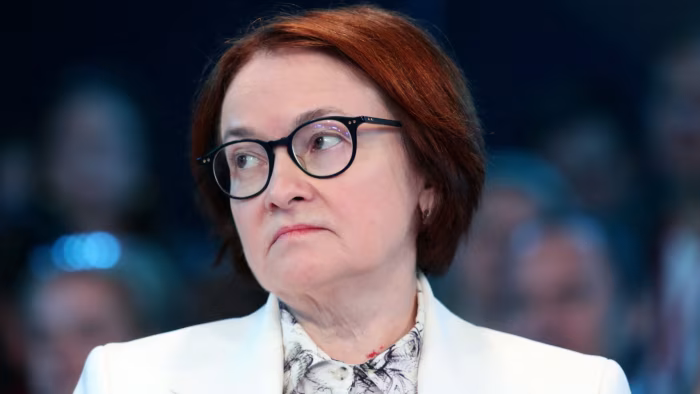After two years of record profits showcasing the resilience of Russia’s wartime economy, the country’s banking sector is showing signs of overheating. Concerns are mounting over the growing share of bad loans, and some of the largest lenders are now under close scrutiny.
Credit Pressure and Push for Lower Rates
Russia’s major financial institutions, particularly those serving corporate clients, have increasingly complained about the difficulty of servicing debt amid high interest rates. Vulnerable sectors like construction, coal, and real estate are especially hard-hit.
In response to this pressure, banks lobbied for interest rate cuts — and in June, the Central Bank finally relented, lowering the key rate from a record 21% to 20%, and again in July to 18%. According to The Financial Times, the Central Bank has signaled it intends to continue cutting rates in pursuit of its 4% inflation target for 2026.
The question, however, is whether these moves are happening fast enough. Some banks appear to have become overexposed to risky sectors and are now struggling with rising credit defaults.
Credit Bank of Moscow Under the Spotlight
One of the most concerning cases is the Credit Bank of Moscow, which has gone through three chairs in less than a year. In June, Expert RA, Russia’s largest credit rating agency, stated there is a “high probability” the bank will need external support — after its net profit dropped by 65% last year.
The bank has historical ties to state energy giant Rosneft, which has previously provided assistance. However, Credit Bank of Moscow did not respond to a request for comment from The Financial Times.
Speaking after the most recent rate cut, Central Bank Governor Elvira Nabiullina insisted there is “no need for the recapitalisation of large banks due to current or potential bad debt overhangs.” According to her, “the true situation with problem loans is better than people sometimes make out.”
She added that the banking sector posted a total profit of ₽1.7 trillion in the first half of 2025. But she also acknowledged that capital “is unevenly distributed across the banking sector” — suggesting that some banks lack adequate buffers.
Experts: Local Issues, but a Broader Warning
Alexandra Prokopenko, a fellow at the Carnegie Russia Eurasia Center in Berlin, explained that the banks now in trouble are mostly those that “pursued aggressive lending strategies last year.” But she cautions against assuming that the entire financial system is in crisis.
In fact, 2024 was a “super bonanza” for Russian banks, which made a record ₽3.8 trillion in profits. “They received enormous bonuses,” Prokopenko noted. “And naturally, they want to keep it going.”
A source regularly in contact with Russian officials confirmed that some banks are indeed significantly affected by non-performing loans — particularly those exposed to Russia’s most troubled sectors. But he stressed that the exposure is “still relatively limited.”
He also pointed out that the Central Bank has “a wide range of instruments” to support balance sheets and help restructure credit portfolios. For example, in 2017, the Central Bank spent over ₽1 trillion to rescue three of the country’s largest private lenders: Otkritie, Promsvyazbank, and B&N Bank.
“Is it concerning? Yes. Is it very concerning? I wouldn’t say so,” he concluded.
Even Banking Giants Feel the Pain
Even Russia’s financial heavyweights — Sberbank and VTB — are not immune. According to Sberbank’s latest report, its cost of risk rose to 1.71% in Q2 2025, up from 0.97% a year earlier. The bank also significantly increased its provisions for bad loans. VTB reported similar trends.
“We expect the situation to stabilise,” said Sberbank CFO Taras Skvortsov during the company’s earnings call. He believes the easing monetary policy will improve portfolio quality and reduce credit risks.
Slumping Profits Across the Sector
According to RBC, 5 of Russia’s 13 systemically important banks saw their net profits fall by 20% or more in the first half of 2025 — including Credit Bank of Moscow. Overall, 48 of the country’s top 100 banks reported weaker financial performance compared to the same period last year.
Vasily Astrov, economist at the Vienna Institute for International Economic Studies, noted that “very few companies can afford to borrow at such high interest rates.” He added that many corporate loans had floating rates, and now that base rates are much higher, those debts must be refinanced on unfavorable terms — creating significant financial stress.
A former Central Bank official confirmed that prolonged high rates inevitably lead to an increase in non-performing loans, as “non-subsidised borrowers simply can’t afford expensive bank credit.” The official added, “Either they receive forbearance and support, or the Central Bank will be forced to bring the rate down.”
Despite the Central Bank’s assurances, the Russian banking sector is showing clear signs of strain. Rising credit defaults, declining profits, and growing inequality in capital buffers all point to a system under pressure. While the risks remain contained for now, the pace of monetary easing and the sector’s ability to adapt will be critical in determining whether Russia’s financial stability can be maintained.
This article was prepared based on materials published by The Financial Times. The author does not claim authorship of the original text but presents their interpretation of the content for informational purposes.
The original article can be found at the following link: The Financial Times.
All rights to the original text belong to The Financial Times.


















